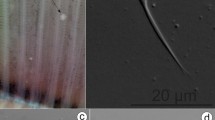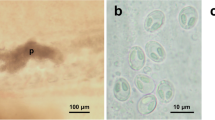Abstract
Purpose
We describe two new Henneguya spp. (Myxobolidae) found parasitizing Cyphocharax modestus from Pardo river, Paraná river basin, municipality of Botucatu, São Paulo State, Brazil: Henneguya fastigata n. sp. from gill lamellae and Henneguya pardensis n. sp. from gill arches. We based the descriptions on myxospore morphology, histology, and small subunit ribosomal DNA sequences.
Methods
In this investigation, 50 specimens of Cyphocharax modestus were examined between July and December 2020 for myxozoan infections. Morphological characterization was based on the mature myxospores. The small subunit ribosomal DNA sequences were used for molecular and phylogenetic study.
Results
Phylogenetic analysis provided the evolutionary position of these new species with other myxobolids species. Myxospores of the two species had similar morphology and morphometrics, but differed in spore body width and length, and ssrDNA sequences differed by 7.2%. These data supported the diagnosis of the parasites as distinct and novel species. The phylogenetic analysis showed a well-supported subclade formed by species that parasitize curimatid fishes, with Henneguya gilbert as a sister species of Henneguya fastigata n. sp., and Henneguya pardensis n. sp. as a sister species of both species.
Conclusion
Our analysis was consistent with previous studies suggesting that orders and families of the hosts are strongly correlated with phylogenetic signals in the Myxobolidae. These are the first species of myxozoans described in the Pardo river.





Similar content being viewed by others
References
Okamura B, Gruhl A, Bartholomew JL (2015) Myxozoan evolution, ecology and development. Springer
Feist M, Longshaw SW (2006) Phylum Myxozoa. In: Woo PTK (ed) Fish diseases and disorders, 2nd edn. CABI Publishing, Wallingford, pp 230–296
Vidal LP, Iannacone J, Whipps CM, Luque JL (2017) Synopsis of the species of Myxozoa grassé, 1970 (Cnidaria: Myxosporea) in the Americas. Neotrop Helminthol 11:413–511
Eiras JC, Adriano EA (2012) A checklist of new species of Henneguya Thélohan, 1892 (Myxozoa: Myxosporea, Myxobolidae) described between 2002 and 2012. Syst Parasitol 83:95–104. https://doi.org/10.1007/s11230-012-9374-7
Silva AMM, Sacomani LB (2001) Using chemical and physical parameters to define the quality of Pardo river water (Botucatu-SP-Brazil). Water Res 35:1609–1616
Vari RP (1998) The Curimatidae, a lowland neotropical fish family (Pisces: Characiformes): distribution, endemism, and phylogenetic biogeography. In: Neotropical Distribution Patterns: Proceedings of a Workshop. Academia Brasileira de Ciências, Rio Janeiro
Vari RP (1992) Systematics of the neotropical characiform genus Cyphocharax Fowler (Pisces: Ostariophysi). Smithson Contrib Zool. https://doi.org/10.5479/si.00810282.529
Vieira DHMD, Abdallah VD, da Silva RJ, de Azevedo RK (2019) Skin nodules associated with parasitism with Henneguya sp. (Cnidaria: Myxosporea) in the neotropical fish Cyphocharax modestus. Microb Pathog 128:294–300. https://doi.org/10.1016/j.micpath.2019.01.027
Abdallah VD, de Azevedo RK, do LuqueBomfim JLTCB (2007) Two new species of Henneguya Thélohan, 1892 (Myxozoa, Myxobolidae), parasitic on the gills of Hoplosternum littorale (Callichthyidae) and Cyphocharax gilbert (Curimatidae) from the Guandu River, State of Rio de Janeiro, Brazil. Parasitol Latinoam 62:35–41
Azevedo RK, Abdallah VD, Paes JVK, da Silva RJ, Matos P, Velasco M, Matos E (2013) Henneguya nagelii n. sp. (Myxozoa: Myxobolidae) in Cyphocharax nagelii (Steindachner, 1881) (Teleostei: Characiformes: Curimatidae) from the Peixe’s River, São Paulo State. Brazil Parasitol Res 112:3601–3605. https://doi.org/10.1007/s00436-013-3546-5
Casal G, Sao Clemente SC, Lopes L, Rocha S, Felizardo N, Oliveira E, Al-Quraishy S, Azevedo C (2017) Ultrastructural morphology and phylogeny of Henneguya gilbert n. sp. (Myxozoa) infecting the teleostean Cyphocharax gilbert (Characiformes: Curimatidae) from Brazil. Parasitol Res 116:2747–2756. https://doi.org/10.1007/s00436-017-5585-9
Martins ML, Onaka EM (2006) Henneguya garavelli n. sp. and Myxobolus peculiaris n. sp. (Myxozoa : Myxobolidae) in the gills of Cyphocharax nagelli (Osteichthyes : Curimatidae) from Rio do Peixe Reservoir, São José do Rio Pardo, São Paulo. Brazil Vet Parasitol 137:253–261. https://doi.org/10.1016/j.vetpar.2005.12.023
Carvalho AAD, Videira MN, Bittencourt LS, Araújo PG, Ferreira RLDS, Tavares JC, Matos ER (2020) Infection of Henneguya sp. on the gills of Metynnis lippincottianus from Curiaú River in eastern Amazon region (Brazil). Rev Bras Parasitol Vet. https://doi.org/10.1590/S1984-29612020037
Sales ROD, Mauad JRC, Honorato CA, Silva KED, Verconti J, Ragagnin PM, Borsuk S, Martin ML, Simionatto S (2020) Histopathology and molecular identification of Henneguya pseudoplatystoma. Lat Am J Aquat Res 48:207–213. https://doi.org/10.3856/vol48-issue2-fulltext-2345
Yuan S, Xu LW, Weng MQ, Zhang JY, Sato H (2021) Outbreak of gill henneguyosis in pond-cultured Oxyeleotris spp. (Eleotridae, Perciformes) caused by Henneguya shaharini Shariff, 1982 (Myxosporea: Bivalvulida) in south China. Aquaculture. https://doi.org/10.1016/j.aquaculture.2021.736587
Bush AO, Lafferty KD, Lotz JM, Shostak AW (1997) Parasitology meets ecology on its own terms: Margolis et al. revisited. J Parasitol. https://doi.org/10.2307/3284227
Lom J, Arthur JR (1989) A guideline for the preparation of species descriptions in Myxosporea. J Fish Dis 12:151–156. https://doi.org/10.1111/j.1365-2761.1989.tb00287.x
Barta JR, Martin DS, Liberator PA, Dashkevicz M, Anderson JW, Feighner SD, Elbrecht A, Perkins-Barrow A, Jenkins MC, Danforth HD (1997) Phylogenetic relationships among eight Eimeria species infecting domestic fowl inferred using complete small subunit ribosomal DNA sequences. J Parasitol 83:262–271
Kent ML, Khattra J, Hedrick RP, Devlin RH (2000) Tetracapsula renicola n. sp. (Myxozoa: Saccosporidae), the PKX myxozoan—the cause of proliferative kidney disease of salmonid fishes. J Parasitol 86:103–111. https://doi.org/10.2307/3284917
Hallett SL, Diamant A (2001) Ultrastructure and small-subunit ribosomal DNA sequence of Henneguya lesteri n. sp. (Myxosporea), a parasite of sand whiting Sillago analis (Sillaginidae) from the coast of Queensland. Australia Dis Aquat Organ 46:197–212. https://doi.org/10.3354/dao046197
Larkin MA, Blackshields G, Brown NP, Chenna R, Mcgettigan PA, McWilliam H, Valentin F, Wallace IM, Wilm A, Lopez R, Thompson JD, Gibson TJ, Higgins DG (2007) Clustal W and Clustal X version 2.0. Bioinformatics 23:2947–2948. https://doi.org/10.1093/bioinformatics/btm404
Ronquist F, Huelsenbeck JP (2003) MrBayes 3: Bayesian phylogenetic inference under mixed models. Bioinformatics 19:1572–1574
Guindon S, Dufayard JF, Lefort V, Anisimova M, Hordijk W, Gascuel O (2010) New algorithms and methods to estimate maximum-likelihood phylogenies: assessing the performance of PhyML 3.0. Syst Biol 59:307–321. https://doi.org/10.1093/sysbio/syq010
Posada D (2008) jModelTest: phylogenetic model averaging. Mol Biol Evol 25:1253–1256. https://doi.org/10.1093/molbev/msn083
Rambaut A (2014) FigTree 1.4.2 software. Inst Evol Biol Univ. Edinburgh. http://tree.bio.ed.ac.uk/software/figtree. Accessed 13 July 2021
Lom J, Dyková I (2006) Myxozoan genera: definition and notes on taxonomy, life-cycle terminology and pathogenic species. Folia Parasitol (Praha) 53:1–36
Molnár K, Marton S, Eszterbauer E, Szekely C (2006) Comparative morphological and molecular studies on Myxobolus spp. infecting chub from the River Danube, Hungary, and description of M-muellericus sp. n. Dis Aquat Organ 73:49–61. https://doi.org/10.3354/dao073049
Zatti SA, Atkinson SD, Maia AAM, Bartholomew JL, Adriano EA (2018) Novel Henneguya spp. (Cnidaria: Myxozoa) from cichlid fish in the Amazon basin cluster by geographic origin. Parasitol Res 117:849–859. https://doi.org/10.1007/s00436-018-5762-5
Cech G, Molnár K, Szekely C (2012) Molecular genetic studies on morphologically indistinguishable Myxobolus spp. infecting cyprinid fishes, with the description of three new species, M-alvarezae sp nov., M-sitjae sp nov and M-eirasianus sp nov. Acta Parasitol 57:354–366. https://doi.org/10.2478/s11686-012-0045-2
Fiala I (2006) The phylogeny of Myxosporea (Myxozoa) based on small subunit ribosomal RNA gene analysis. Int J Parasitol 36:1521–1534. https://doi.org/10.1016/j.ijpara.2006.06.016
Carriero MM, Adriano EA, Silva MRM, Ceccarelli PS, Maia AAM (2013) Molecular phylogeny of the Myxobolus and Henneguya genera with several new South American species. PLoS ONE 8:e73713. https://doi.org/10.1371/journal.pone.0073713
Vieira DHMD, Tagliavini VP, Abdallah VD, de Azevedo RK (2018) Myxobolus imparfinis n. sp. (Myxozoa: Myxosporea), a new gill parasite of Imparfinis mirini Haseman (Siluriformes: Heptapteridae) in Brazil. Syst Parasitol 95:309–318. https://doi.org/10.1007/s11230-018-9776-2
Vieira DHMD, Rangel LF, Tagliavini VP, Abdallah VD, Santos MJ, de Azevedo RK (2020) A new species, Henneguya lacustris n. sp. (Cnidaria: Myxosporea), infecting the gills of Astyanax lacustris from Brazil. Parasitol Res 119:4259–4265. https://doi.org/10.1007/s00436-020-06871-5
Molnár K (2002) Site preference of fish myxosporeans in the gill. Dis Aquat Organ 48:197–207. https://doi.org/10.3354/dao048197
Stilwell JM, Camus AC, Leary JH, Khoo LH, Griffin MJ (2019) Pathologic changes associated with respiratory compromise and morbidity due to massive interlamellar Henneguya exilis infection in channel blue hybrid catfish. J Parasitol 105:686–692. https://doi.org/10.1645/19-28
Ogawa K, Delgahapitiya KP, Furuta T, Wakabayayashi H (1992) Histological studies on the host response to Myxobolus artus Akhmerov, 1960 (Myxozoa: Myxobolidae) infection in the skeletal muscle of carp, Cyprinus carpio L. J Fish Biol 41:363–371. https://doi.org/10.1111/j.1095-8649.1992.tb02665.x
Müller MI, Adriano EA, Ceccarelli PS, da Silva MRM, Maia AAM, Ueta MT (2013) Prevalence, intensity, and phylogenetic analysis of Henneguya piaractus and Myxobolus cf. colossomatis from farmed Piaractus mesopotamicus in Brazil. Dis Aquat Organ 107:129–139. https://doi.org/10.3354/dao02668
Azevedo C, Matos E (1996) Henneguya malabarica sp nov (Myxozoa, Myxobolidae) in the Amazonian fish Hoplias malabaricus. Parasitol Res 82:222–224. https://doi.org/10.1007/s004360050099
Acknowledgments
The authors thank the Fundação de Apoio à Pesquisa do Estado de São Paulo—FAPESP (grants #2020/05412-9, #2019/19060-0, and #2019/26831-2) for the scientific and financial support; and Conselho Nacional de Desenvolvimento Científico e Tecnológico – CNPq (#309125/2017-0).
Author information
Authors and Affiliations
Corresponding author
Ethics declarations
Conflict of interest
The authors declare that they have no conflict of interest related to this study.
Additional information
Publisher's Note
Springer Nature remains neutral with regard to jurisdictional claims in published maps and institutional affiliations.
Supplementary Information
Below is the link to the electronic supplementary material.
Rights and permissions
About this article
Cite this article
Vieira, D.H.M.D., Narciso, R.B., de Azevedo, R.K. et al. Description of Two Novel Henneguya (Cnidaria: Myxosporea) Infecting Curimatid Fish, Using Morphological, Histological, and Molecular Analyses. Acta Parasit. 67, 233–243 (2022). https://doi.org/10.1007/s11686-021-00454-9
Received:
Accepted:
Published:
Issue Date:
DOI: https://doi.org/10.1007/s11686-021-00454-9




